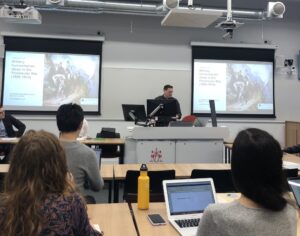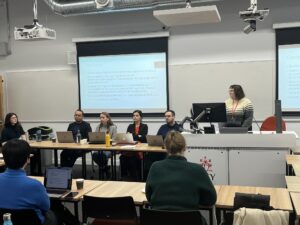by Dr. Matilda Greig (National Army Museum, London)
Humanitarianism and the military should no longer be seen as parallel but separate subjects, and our understanding of both ‘military humanitarianism’ and its chronology need to significantly expand. Rather than seeing it as post-Cold War phenomenon, could we trace the roots of military–humanitarian interaction back to the early nineteenth century, or beyond? This was the central provocation behind the call for contributions for an edited volume, issued in early 2023 by Margot Tudor and Brian Drohan, which was tested on 15th and 16th January 2024 in discussions at a workshop at City, University of London, where contributors to the volume shared the findings from their first drafts. Present to ponder over these questions was a room full of international historians, political scientists, representatives of the International Committee of the Red Cross, myself as an over-eager literary historian, and the most superior conference pastries I’ve ever encountered.

Presentation at Military Humanitarianism: Reimagining the Nexus between Aid Operations and Armed Forces (City, University of London, 15-16 January 2024), photograph by Margot Tudor (2024), all rights reserved
Broadening the definition of military humanitarianism beyond simply military interventions motivated or justified by humanitarian ideals, the editors had challenged us also to think about the many points of connection between the armed forces and humanitarian organisations, and the influence of humanitarian ideals upon military identities and actions, including in peacetime and development work. What immediately became clear was the undeniable liminality between the two sides. Nearly every paper spoke of blurriness and porosity: military officials as preferred candidates for roles in humanitarian organisations, such as the ICRC and UNRRA; humanitarian aid wielded as part of an incomplete decolonisation process or for counterinsurgency motives, including in the UN’s current ‘Quick Impact Projects’; the use of humanitarian terminology by the armed forces, seen in Israel’s discourse of ‘safe zones’ and ‘humanitarian corridors’ during their attacks on Gaza.

Presentation at Military Humanitarianism: Reimagining the Nexus between Aid Operations and Armed Forces (City, University of London, 15-16 January 2024), photograph by Margot Tudor (2024), all rights reserved
Military actors, too, have often been motivated by humanitarian goals, or have become adept at creating elaborate narratives to protect this sense of humanitarian identity and an understanding of their mission as morally good, sometimes ignoring and erasing much evidence to the contrary, demonising the enemy, or differentiating themselves from their comrades’ behaviour in order to do so. This was evidenced particularly in the papers focusing on the early nineteenth century, with American officers managing to frame the violent capture of Seminole women in 1835-42 as an act of benevolent protection, and British ideas of single-handedly fighting slave-traders in West Africa neglecting to credit decades of resistance by anti-slavery-minded groups locally. As Jessica Reinisch pointed out during the workshop’s roundtable discussion, in fact, ‘doing humanitarianism’ perhaps always involves telling stories about one’s own moral position, often using very selective historical precedents. Examples of the efforts made by the armed forces to control the narrative framing around humanitarian work abounded in the workshop, with military institutions enlisting writers, artists, photographers and leading pop stars to support their storytelling in conflicts throughout time, across the world.

Panel at Military Humanitarianism: Reimagining the Nexus between Aid Operations and Armed Forces (City, University of London, 15-16 January 2024), photograph by Margot Tudor (2024), all rights reserved
The question of how far the scholar’s category of ‘military humanitarians’ would have been accepted by the actors themselves, however, was also underlined throughout the workshop, as was the importance of including more perspectives from those who experienced these humanitarian missions, and the possibility of extra-European origins for what is typically seen as a western European ideological development. Many of these methodological imperatives were drawn out during the roundtable discussion on the first day, with Elisabeth Leake highlighting the challenge that so many units of analysis pose to research. How we manage to look at the experiences of practitioners and recipients without assuming passivity on either side, while also considering organisations and systems as a whole, will be a key consideration for the authors as we move onto our second drafts.
Past & Present was pleased to support this event and supports other events like it. Applications for event funding are welcomed from scholars working in the field of historical studies at all stages in their careers.
